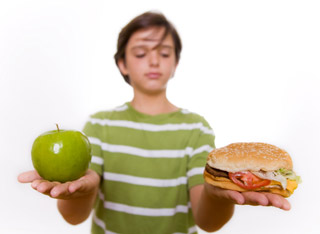Stuff ‘n’ food: Can collectible toys overcome fascination with fast food?
Every parent seems to know what McDonald’s knows: Food and toys outsell food alone. But could toys be used to promote the sale of healthy food as well as calorie-rich fast food?

When Anna McAlister and T. Bettina Cornwell posed that question to two groups of preschoolers, they found a surprising answer: Yes.
The children were allowed to choose a fast-food menu of high-calorie pizza, fries and a soda, or a healthy combination of soup, vegetables and milk. As expected, the kids preferred the fast food, and that was true when the meals were presented without toys or when there was no difference in between the type of toy offered.
But McAlister, a lecturer in the University of Wisconsin–Madison School of Human Ecology, says that when the choice was fast food alone or a healthy food paired with a toy that would complete a collectible set, the kids expected the two foods to taste equally well. “There’s something about the collection that makes the toy especially powerful,” she says.
Despite what “everybody knows” about kids’ preferences for toys along with fast food, the scientific journals did not contain a rigorous study of a marketing tactic embodied in the McDonald’s Happy Meal, McAlister says. “We all know that Happy Meals sell, we observe that kids enjoy them, but until now, there was no research on children’s interest in toys in connection with meal selection. We now have new evidence that the presence of a toy, particularly a collectible one, can change a child’s perception of how the food is going to taste.”
In the Journal of Public Policy and Marketing, McAlister and Cornwell, a professor of marketing at the University of Oregon, described two studies performed with children aged three to five. The children were shown images of meal deals (healthy and “unhealthy”) that were paired with a collectible toy, a noncollectible toy or no toy.
In the first study, the children were asked how they expected the food to taste, using a visual rating scale of frowns and smiles. In the second study, the child had to choose from photos of fast food and healthy food placed side by side.
In both studies, the allure of fast food was counterbalanced by the chance to collect a toy, said Cornwell, a professor of marketing at the University of Oregon. “The study tells us that the inclusion of a collectible toy influences the children’s perceptions of how the food is going to taste and whether they will like it. What was interesting to us was that the presence of the collectible toy moved the healthier food option up to the point that it was just as likable as the fast-food offering.”
The urge to collect, to finish the set, is powerful, says McAlister, who found in a separate study that children were much more likely to choose collectible toys during a game where noncollectible toys were also available as prizes. “We would always ask, casually, ‘Why did you choose that one?’ and 95 percent of the time, they would say some variation of ‘I need all three because they go together.'”
Using toys to sell high-calorie, fast food with little nutritional value is controversial, and earlier this year, Santa Clara County, Calif., restricted the practice in restaurants. McAlister says behavioral approaches could help stem the demand for foods that are feeding an epidemic of childhood obesity that has reached an estimated 17 percent (or 12.5 million children in the United States) — according to the Centers for Disease Control and Prevention — and is driving an epidemic of type II diabetes.
“The most surprising thing was that we expected the collectible toys to have an effect, and expected the meal rating to bounce around according to what toy they were given,” says McAlister, “but we did not anticipate that the healthy meal could ever be rated as high or ever be chosen over the fast food. If you gave the collectible toy only with healthy food, it seems that you could sell a lot more healthy food to kids.”
Tags: research, School of Human Ecology



